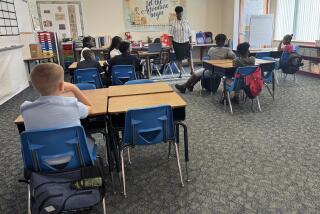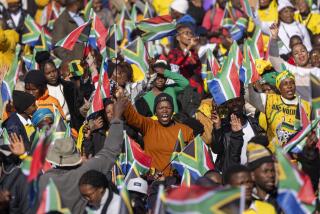Dozens of White Public Schools Open Doors to Blacks : South Africa: In a blow to apartheid, new voluntary government program starts. ANC says it falls short of a single, multiracial system.
JOHANNESBURG, South Africa — Dozens of white public schools opened their doors to all races for the first time Wednesday, cracking an apartheid barrier that has relegated black pupils to separate and unequal township education for more than four decades.
One of the first black youngsters to enter an integrated public school was Mpho Mosohle, a nervous 11-year-old dressed in the gray sweater, shorts and knee socks with the school crest of his new school.
“I’m feeling very proud,” said Mosohle, as he prepared to join morning assembly at Parkview Primary School, where this year 30 of the 177 pupils are either black or Indian.
However, Mosohle admitted to some first-day butterflies, “because I won’t have anyone to talk to today.”
Mosohle’s father, Ignatius, who brought his son to school from their home 20 miles away in Katlehong township, smiled broadly. “At first, they will be a little nervous,” he explained.
Adrian Henning, the school’s headmaster, later addressed his pupils in the school gymnasium, urging them to “be good neighbors” and “look after the children who are new to the school.”
Later, in an interview, Henning said that “having people of different cultures can only enrich things. This is a cross-cultural exchange. That’s the most important thing.”
Parents of pupils in 200 of the country’s 2,000 whites-only public schools took advantage of a new voluntary government program and voted to accept blacks for the 1991 school year, which opened in Johannesburg’s province Wednesday.
The program requires the approval of 72% of the white parents in a school and allows black enrollment only after all whites have enrolled. Only about 10% of the white schools in South Africa chose to vote, but an overwhelming majority of those opted to accept blacks.
The African National Congress and other anti-apartheid groups have criticized the program as a half-measure that falls far short of their demand for a single, multiracial educational system.
“We pay tribute to the white parents who . . . have acted to have the white schools opened to all the children of our country,” Nelson Mandela said this week. But, he added, the government’s open schools plan “is designed to slow down . . . the process of desegregating these schools.”
By partially opening white schools, the government chose the middle ground, partly meeting the black demand for fully integrated schools while holding to its 1989 election promise to maintain whites-only schools for those who want them.
Dozens of white schools have closed because of a lack of white pupils, while black schools are severely overcrowded, with as many as 80 children in a classroom. Anti-apartheid leaders say that allowing 2,000 or so black children to attend white schools doesn’t help much in a black school system with 1 million too many students.
The separate white, black, Indian and mixed-race school systems have provided unequal public education for decades. The government currently spends at least five times more, per pupil, educating whites than blacks. And black education also has been set back by a decade of anti-apartheid school boycotts, teacher strikes and political vandalism.
Last year, only 36% of the black pupils in South Africa passed their high school graduation examinations, the lowest pass rate in history. By comparison, 95% of whites passed the exams.
The government has warned whites that the standards of white public education are destined to drop because the country could never afford to spend as much on blacks as it now spends on whites.
“If (white) people want to maintain their present standards of education, they will have to pay for it out of their pockets,” said Gerrit Viljoen, the government’s minister of constitutional development. “The state can’t use its resources for maintaining that kind of special privilege . . . for whites.”
Mpho Mosohle’s new school, Parkview Primary, couldn’t be more different from his last school, Matsediso Primary, in Katlehong township.
Parkview has 27 students to a classroom; Matsediso has twice that many.
Parkview is an ivy-covered, red-brick building surrounded by a green hedge and encircling a quiet courtyard of blooming flowers. Matsediso is a rectangular school on a treeless lot, surrounded by a chain-link fence and, often, rolls of razor wire for riot control. Every visible window is broken.
The most important difference to Mosohle and his father, though, is that pupils at Parkview didn’t miss a day of school last year while boycotts and strikes cost pupils at Matsediso at least six weeks of classes.
“Black education is worthless. There is no schooling going on there, and we are losing,” Ignatius said. “With no education, in five years’ time, Mpho is nowhere.”
Both Ignatius Mosohle and his son dreamed that Mpho would one day have the opportunity for a good education, and, for the last three years, Mpho has spent his Saturday mornings in a private school to improve his English. At home during the week, his father would hand him the newspaper and say: “Read that story to me.”
Mosohle, a personnel officer at a metal factory, considered enrolling Mpho full-time in a private school, which until Wednesday was the only type of school with multiracial classes. But he couldn’t afford the annual fees, which run about $3,000 a year, compared to the $25 to $100 annual fees at most white public schools.
So they waited in frustration until the government suddenly decided to give white schools the option of opening their doors. Nearly 90% of Parkview’s parents voted overwhelmingly to become a multiracial school.
“To have these kinds of privileges only for us is appalling,” said Colleen Renew, a white mother of two children at Parkview who voted for integration.
More to Read
Sign up for Essential California
The most important California stories and recommendations in your inbox every morning.
You may occasionally receive promotional content from the Los Angeles Times.











